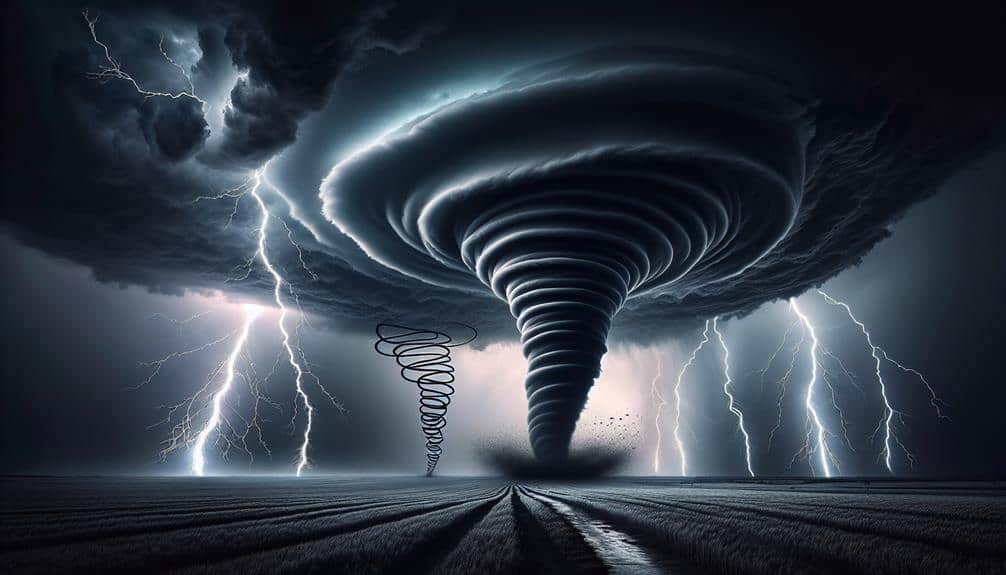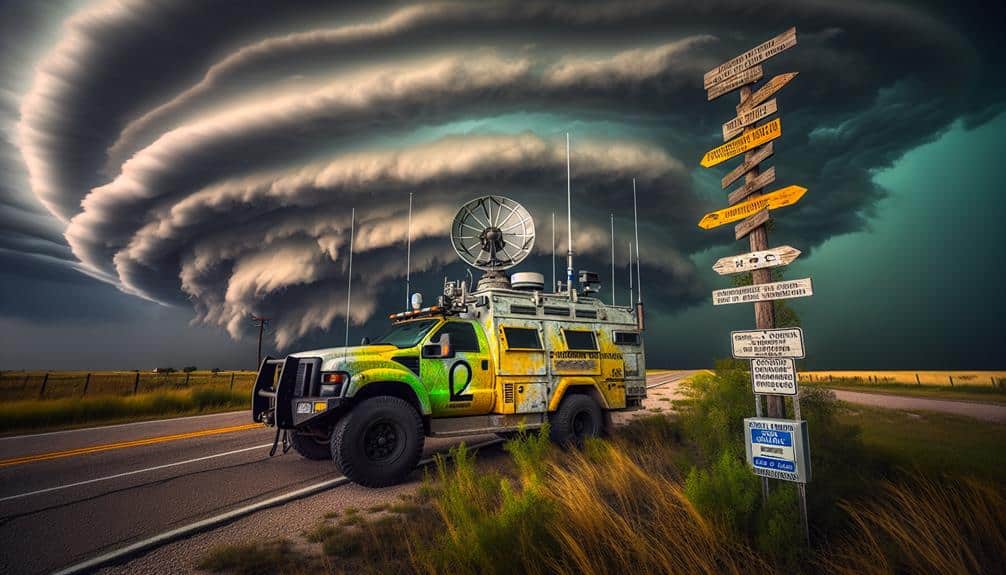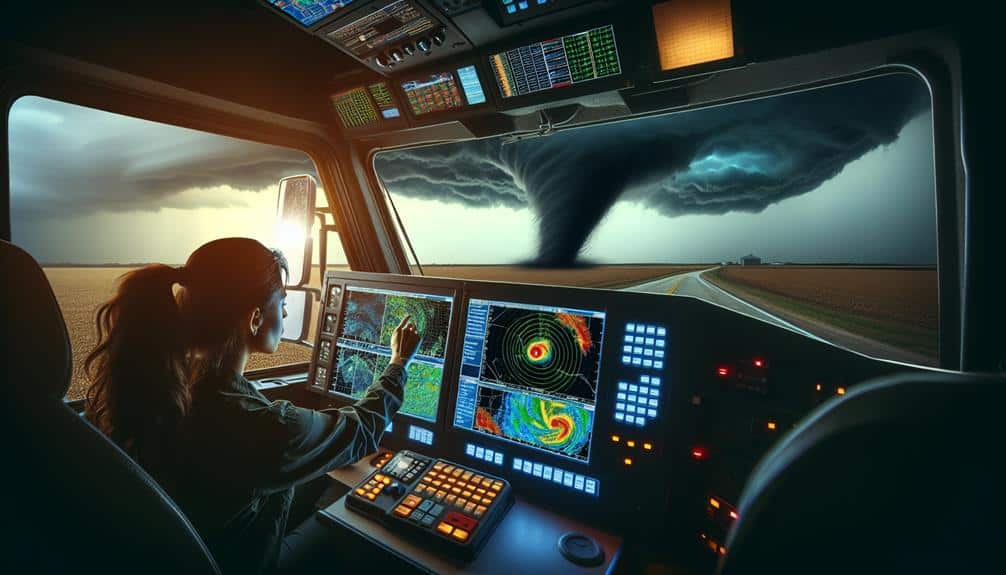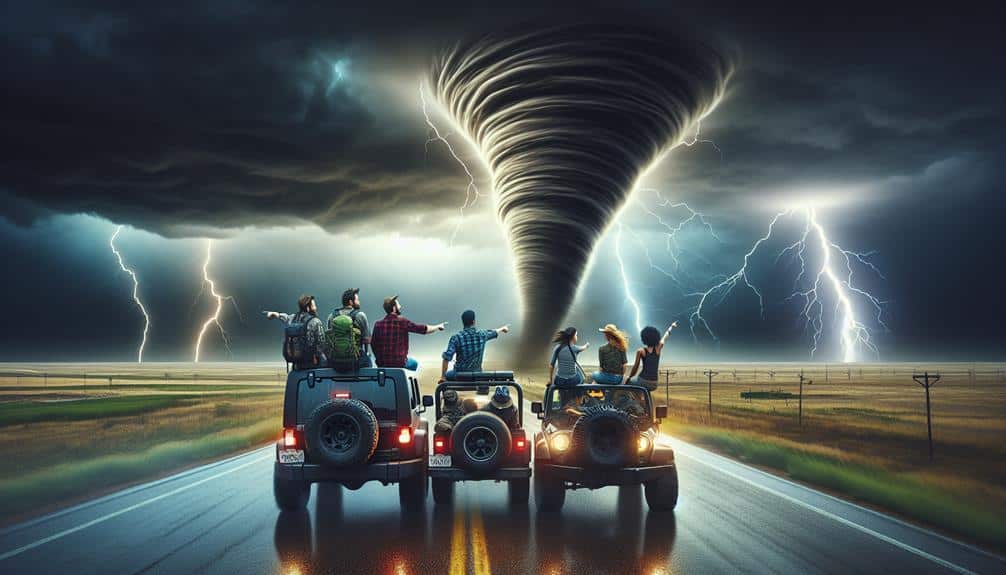To maximize our tornado chasing adventure, we focus on several vital areas. First, select a tour with a strong safety record and advanced technology. We keep abreast of weather forecasts using radar systems and historical data. Essential gear includes high-quality cameras and emergency supplies. Our safety protocols hinge on environmental assessments and pre-planned escape routes. Understanding different tornado types and their formations is essential. Following expert meteorologists and participating in workshops refine our techniques. Staying informed on risks and adhering to local regulations guarantees a successful and thrilling experience. Here are the top 10 tips for a more detailed plan.
Key Points
- Prioritize safety by monitoring weather forecasts and setting alerts for severe weather warnings.
- Choose experienced operators with a strong safety record and advanced technological equipment.
- Pack essential gear, including emergency supplies, personal protective gear, and high-quality cameras.
- Opt for smaller group tours to ensure a more personalized and effective storm chasing experience.
Choose the Right Tour
When selecting a tornado chasing tour, we must analyze the operator's experience, safety record, and the technological equipment they utilize. These factors are crucial to guaranteeing our adventure is both exciting and safe. Tour selection hinges on detailed cost comparison and understanding what we get for our money. Operators with extensive experience and an outstanding safety record often justify higher costs. Thorough data shows that tours led by experienced guides with advanced meteorological tools have a higher success rate in spotting tornadoes.
Group size is another crucial component. Smaller groups generally offer a more personalized experience, and data indicates that guides can provide more detailed attention and insights. Conversely, larger groups might reduce costs but can compromise the quality of the experience.
Reviewing the guide's experience is non-negotiable; seasoned guides are skilled at navigating the unpredictable weather patterns and making real-time decisions that prioritize safety without sacrificing the chase's excitement.
In our pursuit of freedom and adventure, we must perform due diligence in tour selection. Analyzing costs, evaluating group sizes, and ensuring our guide's expertise guarantees we maximize the thrill while minimizing risks.
Check Weather Forecasts
Staying updated on weather forecasts is essential for optimizing our chances of successfully spotting tornadoes while ensuring our safety. Accurate storm tracking allows us to pinpoint potential tornado formations and adjust our plans in real-time. Meteorological data, including wind patterns, humidity levels, and temperature gradients, contribute to our understanding of tornado-prone areas.
To maximize our tornado chasing adventures, we should:
- Monitor Real-Time Data: Utilize radar systems and storm tracking software to observe developing weather conditions.
- Set Alerts: Configure weather apps to send notifications for severe weather warnings and tornado watches.
We need to integrate multiple data sources, such as the National Weather Service (NWS) and Storm Prediction Center (SPC), to create a detailed view of storm activity. This analytical approach not only enhances our chances of witnessing tornadoes but also supports emergency preparedness by alerting us to potential hazards.
Pack Essential Gear
Having identified potential tornado formations through detailed weather tracking, we now need to pack necessary gear to make sure we're well-equipped for the unpredictable conditions of tornado chasing. A thorough gear checklist is essential for both efficiency and safety.
First, let's prioritize our emergency supplies. We should include a first aid kit, a multi-tool, flashlights with extra batteries, and high-energy snacks. Hydration is crucial, so pack enough water to last at least 24 hours. Additionally, a NOAA weather radio will keep us updated on real-time weather changes.
Data collection is a fundamental part of our expedition. For this reason, we need high-quality cameras and video equipment with spare memory cards and batteries. A GPS unit, preferably one designed for rugged conditions, will help us navigate through unfamiliar terrain.
Personal protective gear can't be overlooked. Sturdy footwear, weather-resistant clothing, and a helmet can protect us from debris. A portable charger and a power bank are indispensable for keeping our devices operational.
Lastly, let's not forget about our vehicle. Make sure we've a spare tire, a jack, jumper cables, and a car emergency kit. This detailed preparation guarantees we maximize our freedom while maintaining operational efficiency.
Prioritize Safety First
Ensuring our safety requires a methodical evaluation of potential risks and the implementation of proactive measures. Prioritizing safety in tornado chasing isn't just about following our intuition; it demands strict adherence to established safety protocols and robust emergency plans.
First, we need to assess the environmental conditions and understand the real-time data that meteorological tools provide. This data-driven approach minimizes our exposure to unforeseen hazards.
Our safety protocols must be thorough and meticulously designed. These should cover everything from vehicle maintenance to communication strategies, ensuring that we're prepared for every possible scenario.
- Regular Communication: We maintain constant contact with local weather stations and emergency services, using reliable communication devices.
- Vehicle Readiness: Our vehicles should be equipped with essential gear, including first aid kits, emergency supplies, and GPS systems.
Understand Tornado Types

To improve our tornado chasing effectiveness, we must thoroughly comprehend the different types of tornadoes and their distinct characteristics.
Tornadoes are generally classified into three primary types: supercell, landspout, and waterspout. Supercell tornadoes are the most intense, often forming from a rotating updraft called a mesocyclone. These tornadoes can reach wind speeds over 200 mph, making them the most dangerous. Understanding tornado formation in supercells is vital, as it informs our storm chasing techniques and helps us predict their paths more accurately.
Landspouts, on the other hand, form from ground-level vorticity stretching upward into a cumulus cloud base. They usually have weaker wind speeds compared to supercell tornadoes but can still pose significant risks.
Waterspouts, similar to landspouts, form over bodies of water and can shift into land-based tornadoes if they move ashore.
Learn From Experts
Learning from experienced storm chasers and meteorologists provides us with invaluable insights and strategies that enhance our tornado chasing accuracy and safety. By tapping into expert opinions, we access a wealth of knowledge that helps us refine our chasing techniques and comprehend complex storm patterns more effectively.
Expert guidance often includes critical safety guidelines and data-driven methodologies that minimize risks. Understanding storm patterns is fundamental, as these insights allow us to predict tornado formation and behavior with greater precision. This technical knowledge empowers us to make informed decisions in high-stakes environments, maximizing our safety and observational success.
- Attend Workshops and Seminars: These are excellent venues to gain firsthand insights from seasoned storm chasers and meteorologists.
- Follow Reputable Weather Blogs and Forums: Staying updated with expert opinions and current chasing techniques guarantees we're well-prepared for any chasing endeavor.
Respect Local Regulations

We must guarantee compliance with local regulations by securing necessary permits and permissions prior to any chase.
Identifying designated safety zones is vital, as data shows these areas greatly reduce injury risks.
Additionally, understanding the legal consequences of non-compliance can prevent costly fines and legal issues.
Permits and Permissions Needed
Securing the necessary permits and permissions is essential for lawful and ethical tornado chasing, guaranteeing compliance with local regulations and safety protocols. Understanding the permit process and adhering to specified safety measures can enhance our chasing experience while respecting local laws.
Obtaining permits can vary by region, requiring us to consult with local authorities or land management agencies to determine specific requirements.
By following these essential steps, we can streamline the permit process:
- Research Local Regulations: Each region has unique laws and guidelines on tornado chasing. Familiarize ourselves with these by visiting governmental websites or contacting relevant authorities.
- Apply Early: Permit applications often require processing time. Submitting applications well in advance ensures we've all necessary documentation before embarking on our adventure.
Our commitment to securing permits and adhering to safety guidelines not only enhances our personal safety but also fosters positive relationships with local communities. This data-driven approach to tornado chasing guarantees we operate within legal boundaries while maximizing our freedom to pursue this thrilling activity.
Safety Zones Identification
Identifying safety zones is crucial for minimizing risks during tornado chasing, optimizing compliance with local regulations and protocols. We need to map out safe zones in advance, integrating data from meteorological sources and local emergency management agencies.
Detailed emergency plans should include designated shelter options and clearly marked evacuation routes to enhance our situational awareness and readiness.
Analyzing historical tornado paths and local infrastructure data can pinpoint ideal shelter options. Public buildings with reinforced structures, such as schools and community centers, often serve as designated safe zones. We should verify these locations with local authorities to optimize they're part of established emergency plans.
Additionally, mobile apps and real-time alerts can provide instant updates on the nearest safety zones.
Evacuation routes must be planned meticulously, using GIS data to identify the most efficient paths away from the tornado's projected path. Local regulations often require that we adhere to these predefined routes to avoid bottlenecks and ensure a swift, orderly evacuation.
Legal Consequences Awareness
Understanding the legal consequences of tornado chasing and strictly adhering to local regulations is essential to ensure both personal safety and legal compliance. As enthusiasts of chasing these powerful storms, we must be aware of the myriad regulations put in place to manage risk and uphold public safety. Ignorance of the law isn't a viable defense, and failure to comply can result in severe legal consequences.
Taking safety precautions is paramount. We need to be prepared to coordinate our activities with local authorities and respect restricted areas. Proper risk management involves knowing the specific regulations of the areas we plan to chase in and having well-documented emergency plans.
Here's a quick breakdown of critical considerations:
- Know Local Laws: Different jurisdictions have varying laws regarding storm chasing. Confirm we're compliant with all local regulations.
- Secure Permits if Required: Some areas require special permits for activities that involve potential hazards. Obtaining these permits can mitigate legal ramifications.
Capture Stunning Photos
When capturing breathtaking photos of tornadoes, we must focus on peak camera settings and perfect shot timing. Utilizing a fast shutter speed and high ISO can help freeze the motion of the tornado, while a wide aperture guarantees sufficient light intake.
Timing the shots just as the tornado forms or dissipates provides the most dramatic and dynamic images.
Optimal Camera Settings
To capture stunning photos of tornadoes, we should set our cameras to a low ISO, wide aperture, and fast shutter speed, ensuring sharp and vibrant images despite challenging conditions. This combination helps us manage lighting adjustments and maintain image clarity even in rapidly changing environments.
Lighting adjustments are essential when photographing tornadoes. A low ISO (100-400) minimizes noise, while a wide aperture (f/2.8-f/4) allows more light into the sensor, creating a bright image. Complement this with a fast shutter speed (1/1000s or faster) to freeze the motion of debris and the tornado itself.
Proper focus techniques are vital. We should use continuous autofocus (AF-C) mode to track the tornado's movement, ensuring our subject remains sharp. Additionally, manual focus can be beneficial in low-light conditions or when autofocus struggles.
Here are some key points to keep in mind:
- Lighting Adjustments: Use a low ISO and wide aperture for best image quality.
- Focus Techniques: Utilize continuous autofocus and manual focus as necessary.
For framing techniques, think about the Rule of Thirds to create a balanced composition. Post-processing can further refine our photos by adjusting contrast and sharpening, making each shot stand out.
Perfect Shot Timing
Timing our shots precisely during tornado chases enhances the potential for capturing dramatic and awe-inspiring images. By analyzing weather patterns and strategically selecting chase locations, we improve our chances of encountering the perfect storm. Our storm chasing strategies rely heavily on real-time data from Doppler radar and satellite imagery to predict tornado formation.
When it comes to photography techniques, we need to be ready to act swiftly. The key is understanding the lifecycle of a tornado. Typically, the most photogenic moments occur during the mature stage, where the funnel is fully developed. We use high-speed continuous shooting modes to capture the rapid changes in the storm's structure.
To further refine our timing, we monitor the mesocyclone's rotation speed. Faster rotation often indicates imminent tornado formation. We position ourselves east or southeast of the storm, where lighting conditions are ideal, and the tornado's path is predictable.
Additionally, understanding the nuances of light and shadow interplay helps create striking compositions. The golden hour, just before sunset, often provides the best lighting conditions.
Stay Informed on Risks

Staying informed on risks involves leveraging real-time meteorological data and advanced predictive models to anticipate tornado activity accurately. By conducting thorough risk assessment and engaging in meticulous preparedness planning, we can maximize our chances of safely navigating these powerful natural phenomena.
We're not just chasing tornadoes; we're harnessing cutting-edge technology and data analytics to make sure that we have the most up-to-date information.
Here's how we can stay informed on risks:
- Meteorological Data Sources: Utilize reliable sources like NOAA's Storm Prediction Center, which provides detailed forecasts and severe weather alerts.
- Predictive Models: Implement advanced models such as the High-Resolution Rapid Refresh (HRRR) to predict tornado formation and track.
Enjoy the Experience
Let's quantify the thrill we experience during tornado chasing by analyzing the surge in adrenaline levels, measured in micrograms per deciliter, which peak during high-intensity moments.
Concurrently, we should leverage high-resolution cameras to capture data-rich visuals, ensuring we document the stunning meteorological phenomena.
These practices not only enhance our personal engagement but also contribute valuable information to our research archives.
Savor the Adrenaline
Frequently, the rush of adrenaline we experience during tornado chasing can be quantified by monitoring our heart rates and stress levels, providing valuable physiological data. The thrill-seeking aspect of our adventures isn't just about the excitement; it's also about understanding how we manage and mitigate risks in such volatile environments. Balancing the intense desire for freedom with practical risk management strategies is essential.
By analyzing our physiological responses, we can gauge the intensity of our experiences and make informed decisions to optimize both safety and enjoyment. This approach guarantees we're not only chasing the next thrill but also maintaining a level of control and preparedness.
Heart Rate Variability (HRV): Monitoring HRV can indicate our stress levels and overall readiness to handle the high-stakes environment.
Cortisol Levels: Tracking cortisol, a stress hormone, helps us understand how our bodies react under pressure and can guide us in managing stress more effectively.
Adrenaline Spikes: Measuring adrenaline levels provides insight into the peak moments of excitement, allowing us to identify and analyze the most thrilling parts of our chases.
Let's embrace the science behind our thrill-seeking ventures, ensuring we optimize our experiences while keeping safety at the forefront.
Capture Stunning Moments
While managing physiological responses is necessary for safety, capturing breathtaking moments of tornadoes also demands precision and technical expertise. First and foremost, our photography tips include using a sturdy tripod to guarantee stability, given the severe weather conditions.
A wide-angle lens facilitates capturing the vastness of the storm structure, while a fast shutter speed guarantees clarity amidst rapid movements.
When it comes to chasing techniques, maintaining a safe distance is vital. We recommend a minimum of one mile from the tornado's path. This distance allows us to use telephoto lenses effectively, ensuring we capture high-resolution images without compromising safety. GPS devices and real-time radar apps are indispensable for tracking tornado movements accurately.
Additionally, understanding the storm's lifecycle is essential. Tornadoes exhibit distinct stages—from formation to dissipation—which offer unique photographic opportunities. By analyzing weather data and storm patterns, we can anticipate these stages and position ourselves optimally.
Finally, post-processing is where our captured moments transcend into stunning visual narratives. Using software like Adobe Lightroom, we can enhance contrast, sharpen details, and correct exposure, ensuring our images reflect the raw power and beauty of tornadoes.
Through meticulous planning and execution, we can capture extraordinary moments that resonate with the essence of freedom and adventure.
Frequently Asked Questions
What Is the Best Time of Year for Tornado Chasing?
The greatest time for tornado chasing is during tornado season, typically from April to June. During this period, weather patterns align to create ideal conditions, maximizing our chances for observing tornadoes while ensuring data collection is reliable.
How Do I Find Reputable Tornado Chasing Tours?
To find reputable tornado chasing tours, we should analyze tour operator recommendations and verify their safety precautions. Reviewing data-driven testimonials and safety records guarantees we choose tours that prioritize both thrilling experiences and our safety.
Are There Any Age Restrictions for Tornado Chasing Adventures?
Safety's paramount to us. Yes, there are age restrictions for tornado chasing adventures. Regulations typically require participants to be 18+, but younger enthusiasts can join with parental consent and adherence to strict safety precautions.
What Kind of Vehicle Is Best for Chasing Tornadoes?
We recommend using a sturdy SUV or truck for tornado chasing. These vehicles offer superior vehicle safety and maneuverability. Equipping them with storm tracking technology guarantees precise navigation, enhancing our ability to chase safely and effectively.
How Experienced Should I Be Before Going on a Tornado Chase?
When it comes to tornado chasing, we've got to make sure our ducks are in a row. The necessary experience involves advanced safety precautions and a high skill level. Thorough preparation is needed to mitigate risks and maximize freedom.


